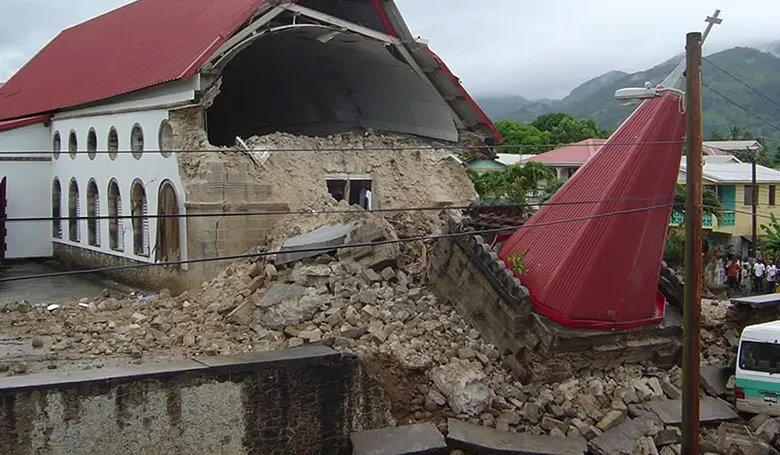Earthquakes in Dominica

Earthquakes in Dominica occur frequently due to its position along the Lesser Antilles volcanic arc, where tectonic interactions between the Caribbean and Atlantic plates drive seismic activity. The island is home to nine volcanic centers, including Morne Diablotin, Morne Trois Pitons, and Morne Plat Pays, contributing to volcanic and seismic activity. Dominica experiences regular earthquake swarms, particularly near active volcanic sites, and its history includes several significant events that have impacted local communities and infrastructure. The UWI Seismic Research Centre (SRC) and Dominica Public Seismic Network (DPSN) play key roles in monitoring these seismic activities and providing early warnings.
Significant Earthquake Events in Dominica
The most impactful earthquake in recent memory was the November 21, 2004 Les Saintes earthquake, which registered a magnitude of 6.3. Centered offshore near the Les Saintes archipelago, this earthquake affected Dominica and Guadeloupe, causing extensive structural damage across Dominica’s northwest. Prime Minister Roosevelt Skerrit declared a state of emergency in the hardest-hit areas, where landslides cut off villages and rivers overflowed, including the Melville Hall River, which rendered the Melville Hall Aiport, Dominica’s only airport temporarily inoperative. Additionally, the earthquake caused the Boiling Lake to drain twice, an effect attributed to extensional strain from the seismic activity. This event remains the most studied earthquake in Dominica due to its impact on infrastructure, natural features, and communities.
Below is a list of notable earthquakes that have affected Dominica:
- 1843: A significant earthquake affected Dominica, though exact magnitude data is unavailable. Reports indicate widespread impact across the island.
- 1969: A 6.1 magnitude earthquake struck offshore, affecting Dominica and nearby islands.
- 1974: Another 6.1 magnitude earthquake shook the Eastern Caribbean, including Dominica.
- 1982: A 6.0 magnitude earthquake impacted the northern parts of Dominica and Guadeloupe.
- 1995: Northeast of Dominica, a magnitude 6.2 earthquake was recorded, also affecting nearby islands.
- 2004 Les Saintes earthquake: The 6.3 magnitude earthquake, one of the most significant on record, caused widespread damage, landslides, and temporarily drained Boiling Lake.
- 2009-2010: Earthquake swarms were documented around Morne aux Diables, indicating potential magma movement beneath the surface.
- 2023: A 6.1 magnitude earthquake centered off Guadeloupe was felt in parts of Dominica.
- 2024: A swarm of over 300 minor earthquakes in northern Dominica highlighted ongoing seismic activity, which the SRC continues to monitor closely.
Seismic Patterns and Volcanic Activity
Dominica’s earthquakes often occur in swarms, especially around volcanic centers like Morne aux Diables and Wotten Waven Caldera. Swarming patterns—clusters of quakes in a short period – usually indicate subsurface magma movement, which can foreshadow volcanic eruptions. Notable swarming events in 2009, 2010, and 2024 emphasize the island’s ongoing seismic activity and the need for careful monitoring by agencies such as the SRC and DPSN. Earthquakes near volcanic areas can also create cascading effects, such as landslides, which pose further risks in mountainous regions of Dominica.
Risks, Infrastructure, and Preparedness
Dominica’s combination of seismic and volcanic activity presents distinct risks, from potential landslides and pyroclastic flows to infrastructure challenges, especially in populated areas close to pyroclastic deposits, like Roseau near the Wotten Waven Caldera. Dominica’s DPSN and Office of Disaster Management work together to provide public education on earthquake preparedness and resilience. These agencies emphasize the importance of monitoring and preparedness for reducing risks associated with earthquakes and volcanic activity. Through efforts to build public awareness and resilience, Dominica aims to protect communities and maintain essential services during future seismic events.
The island’s seismic monitoring infrastructure and historical data on earthquake patterns allow local and regional agencies to provide timely alerts and develop effective disaster response strategies. Dominica’s volcanic nature contributes to its vulnerability, but it also enables scientists to study the intricate dynamics of Caribbean tectonics and prepare for potential natural events in the region.




